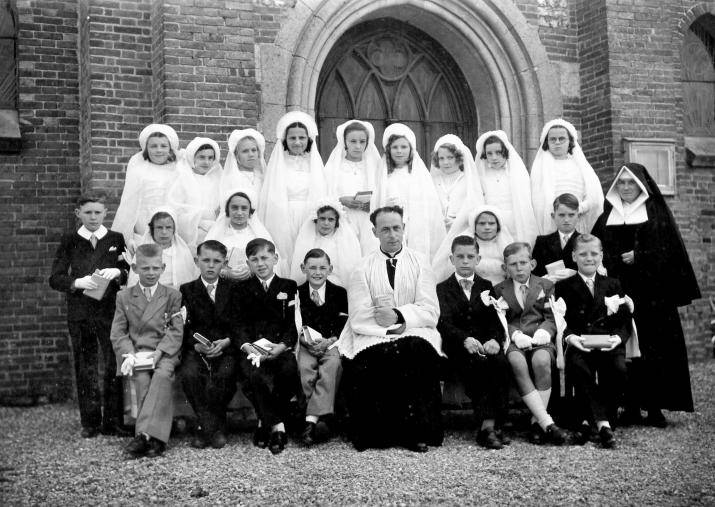
French Post-War First Communion Outfits (1945-49)

Figure 1.--Here we see a group of French children doing their First Communion in June 1949. It looks like a church group rather than a school group. The boys wear suits and the girls junior wedding dresses. We think this is a group of appropriate age children from the Church rather than a school class. A French reader tells us, "HBC is right, they are not specialy pupils of a Catholic school. Notice, how the boy were dressed in 1940s, with long or short suits, all have got armband, meaning Solemn Communion." Notice only one boy ears short pants. Alb for boys Communion began in fashion after 1950. The boys wore their alb during the chuch ceremony and then changed it for their suit with a armband during
the rest of this great day.
|
|
We see children wearing pre-War styles for their First Communion outfits after World War II. Conditions were very difficult immediately after the War, but First Communiion was very important. Conditions rapidly improved, especially after the American Marshall Plan helped stimulate the European economic recovery (1948). First Communion styles in the late 1940s were still similar to pre-War styles. We notice a range of styles being worn for First Communion. This included Eton suits, sailor suits, and various other suits. Cassocks were not common, but beginning to appear. The Eton suits and sailor suits, however, seem less common than befote the War. Mostly we see boys wearing suits. Dark suits were the most commomn. We note both long and short pants suits. For many boys it was their first pair of long pants or at least their first long pants suit. Many boys wore long paants First Communion nsuits at a time when many were still wearing short pants. We suspect a factor here is that suits could be worn for a range of occassions, unlike outfits purchased just for First Communion. The girls, however, continued to wear the junior wedding dresses that were just for First Communion. A French reader tells us, "The girl junior wedding dresses was the rule untill 1970s; this garment is quite expensive. One can also find the same think with the baptism dresses for baby boys or girls. Some are very precious and were passing from family babies to babies on. Today we can still see this tradition here or there in France and DOM-TOM. One can always find them at some luxury boutique. According the 'règles de bonnes manières', a baby baptism dress couldn't be, either loaned, or rented other tan from family members."
Here we see the boys participating in Communion Solennelle at Orgelet, a cgarming medieval town duing 1948. Orgelet is a small medieval town in Jura, part of the Franche Comte region. It is located close to the Swiss border in eastern France. Sites to see in the region include the Église de Brou (46 km), Brancion (The Old Town) (62 km), Mâcon Saint-Vincent Cathedral (64 km), or Ursulines Museum (Musée des Ursulines) (64 km). As the communicants are all boys, we believe this is a school group. The boys here wear mostly suits, both double-breasted and single-breasted, but the double-brasted suits were the most common. This probably reflects the formality of the occassion. Only onec boy weara a sailor suit. None of the boys wears an Eton collar. This may reflect the fact that it cwas only a few years after the war. More likely it is the provincial setting. We suspect that the fancier Eton suits and saior suits woukd be nore common in Paris. As far as we can tell, most of the boys wear long pasts suits. Only two boys wear short pnts suits, both with white knee socks and theu have been placed in the front. The boys look to be about 10-11 years old.
Church Group (1949)
Here we see a group of French children doing their First Communion during June 1949 (figure 1). It looks like a church group rather than a school group. The boys wear suits and the girls junior wedding dresses. We think this is a group of appropriate age children from the Church rather than a school class. A French reader tells us, "HBC is right, they are not specialy pupils of a Catholic school. Notice, how the boy were dressed in 1940s, with long or short suits, all have got armband, meaning Solemn Communion." Notice only one boy ears short pants. Alb for boys Communion began in fashion after 1950. The boys wore their alb during the chuch ceremony and then changed it for their suit with a armband during the rest of this great day. The children look to be about 10-years old. A priest and nun who helped prepare them are included in the portrait.
HBC

Navigate the Historic Boys' First Communion pages:
[Return to the Main French First Communion post-war decade page]
[Return to the Main French First Communion post-war page]
[Return to the Main First Communion page]
[Renewals]
[America]
[France]
[Spain]
[Switzerland]
Navigate the Historic Boys' Clothing Web Site:
[Introduction]
[Activities]
[Biographies]
[Chronology]
[Clothing styles]
[Countries]
[Bibliographies]
[Contributions]
[FAQs]
[French glossaries]
[Images]
[Links]
[Registration]
[Tools]
[Boys' Clothing Home]
Navigate the Historic Boys' Clothing Web chronological pages:
[The 1920s]
[The 1930s]
[The 1940s]
[The 1950s]
[The 1960s]
[The 1970s]
Navigate the Historic Boys' Clothing Web style pages:
[Short pants suits]
[Blazers]
[Jackets]
[Kilts]
[Sailor suits]
[Sailor hats]
[Ring bearer/page costumes]
[Shortalls]
Created: 3:01 AM 6/10/2011
Last edited: 11:44 PM 1/23/2012



